Pen name Meer Name Mir Mir Role Poet | Period Mughal era India Influenced Ghalib Subject Love, philosophy | |
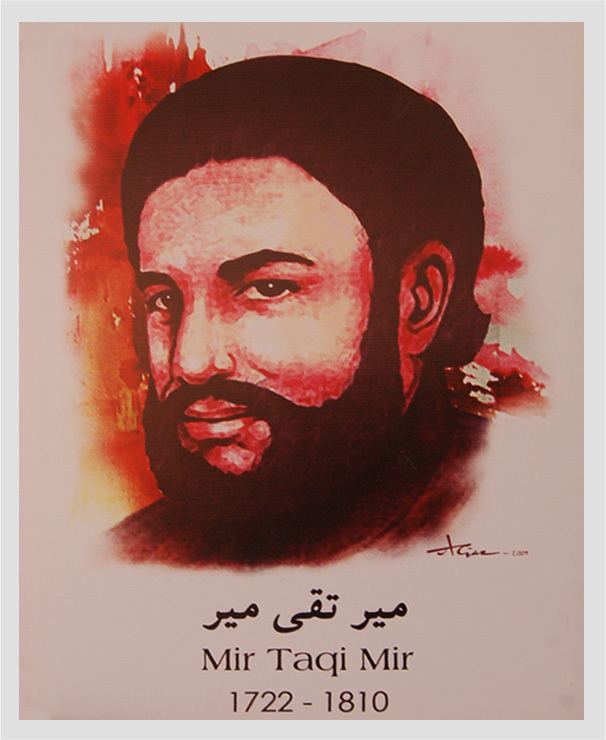 | ||
Born 1723Agra ( 1723 ) Books Zikr-i Mir, Mir Taqi Mir, selected poetry Similar People Ghalib, Nasir Kazmi, Muhammad Iqbal, Mir Tanha Yousafi | ||
Zikr e mir mir taqi mir
Meer Muhammad Taqi Meer (Urdu: مِیر تقی مِیرؔ—Mīr Taqī Mīr), whose takhallus (pen name) was Mir (Urdu: مِیرؔ—Mīr) (sometimes also spelt Meer Taqi Meer), was the leading Urdu poet of the 18th century, and one of the pioneers who gave shape to the Urdu language itself. He was one of the principal poets of the Delhi School of the Urdu ghazal and remains arguably the foremost name in Urdu poetry often remembered as Khudā-e Sukhan (God of Poetry).
Contents
- Zikr e mir mir taqi mir
- Mir taqi mir dekh to dil mehdi hassan ws
- Life
- Literary life
- Mir and Mirza Ghalib
- Famous couplets
- Mir Taqi Mir in fiction
- Major works
- References
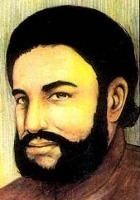
Mir taqi mir dekh to dil mehdi hassan ws
Life
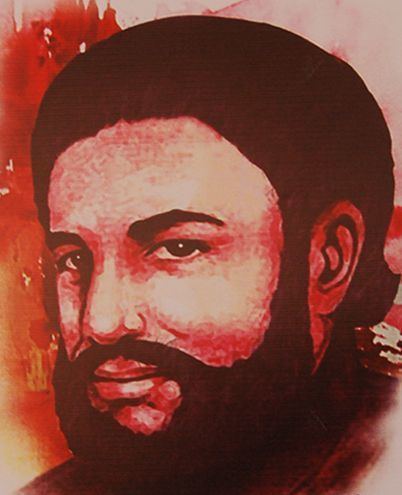
The main source of information on Mir's life is his autobiography Zikr-e-Mir, which covers the period from his childhood to the beginning of his sojourn in Lucknow. However, it is said to conceal more than it reveals, with material that is undated or presented in no chronological sequence. Therefore, many of the 'true details' of Mir's life remain a matter of speculation.
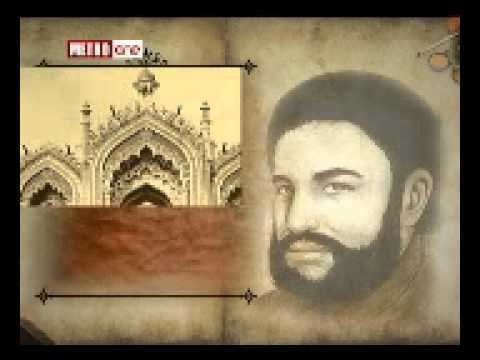
Mir was born in Agra, India (then called Akbarabad and ruled by the Mughals) in August or February 1723. His philosophy of life was formed primarily by his father, a religious man with a large following, whose emphasis on the importance of love and the value of compassion remained with Mir throughout his life and imbued his poetry. Mir's father died while the poet was in his teens. He left Agra for Delhi a few years after his father's death, to finish his education and also to find patrons who offered him financial support (Mir's many patrons and his relationship with them have been described by his translator C. M. Naim).
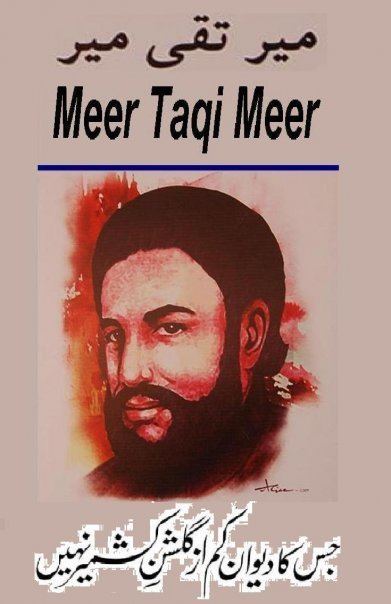
Some scholars consider two of Mir's masnavis (long narrative poems rhymed in couplets), Mu'amlat-e-ishq (The Stages of Love) and Khwab o khyal-e Mir ("Mir's Vision"), written in the first person, as inspired by Mir's own early love affairs, but it is by no means clear how autobiographical these accounts of a poet's passionate love affair and descent into madness are. Especially, as Frances W. Pritchett points out, the austere portrait of Mir from these masnavis must be juxtaposed against the picture drawn by Andalib Shadani, whose inquiry suggests a very different poet, given to unabashed eroticism in his verse.
Mir lived much of his life in Mughal Delhi. Kuchha Chelan, in Old Delhi was his address at that time. However, after Ahmad Shah Abdali's sack of Delhi each year starting 1748, he eventually moved to the court of Asaf-ud-Daulah in Lucknow, at the king's invitation. Distressed to witness the plundering of his beloved Delhi, he gave vent to his feelings through some of his couplets.
کیا بود و باش پوچھے ہو پورب کے ساکنو
ہم کو غریب جان کے ہنس ہنس پکار کے
دلّی جو ایک شہر تھا عالم میں انتخاب
رہتے تھے منتخب ہی جہاں روزگار کے
جس کو فلک نے لوٹ کے ویران کر دیا
ہم رہنے والے ہیں اسی اجڑے دیار کے
Mir migrated to Lucknow in 1782 and remained there for the remainder of his life. Though he was given a kind welcome by Asaf-ud-Daulah, he found that he was considered old-fashioned by the courtiers of Lucknow (Mir, in turn, was contemptuous of the new Lucknow poetry, dismissing the poet Jur'at's work as merely 'kissing and cuddling'). Mir's relationships with his patron gradually grew strained, and he eventually severed his connections with the court. In his last years Mir was very isolated. His health failed, and the untimely deaths of his daughter, son and wife caused him great distress.
He died, of a purgative overdose, on Friday, 21 September 1810. The marker of his burial place was removed in modern times when a railway was built over his grave.
Literary life
His complete works, Kulliaat, consist of six Diwans containing 13,585 couplets, comprising all kinds of poetic forms: ghazal, masnavi, qasida, rubai, mustezaad, satire, etc. Mir's literary reputation is anchored on the ghazals in his Kulliyat-e-Mir, much of them on themes of love. His masnavi Mu'amlat-e-Ishq (The Stages of Love) is one of the greatest known love poems in Urdu literature.
Mir lived at a time when Urdu language and poetry was at a formative stage – and Mir's instinctive aesthetic sense helped him strike a balance between the indigenous expression and new enrichment coming in from Persian imagery and idiom, to constitute the new elite language known as Rekhta or Hindui. Basing his language on his native Hindustani, he leavened it with a sprinkling of Persian diction and phraseology, and created a poetic language at once simple, natural and elegant, which was to guide generations of future poets.
The death of his family members, together with earlier setbacks (including the traumatic stages in Delhi), lend a strong pathos to much of Mir's writing – and indeed Mir is noted for his poetry of pathos and melancholy.
Mir and Mirza Ghalib
Mir's famous contemporary, also an Urdu poet of no inconsiderable repute, was Mirza Rafi Sauda. Mir Taqi Mir was often compared with the later day Urdu poet, Mirza Ghalib. Lovers of Urdu poetry often debate Mir's supremacy over Ghalib or vice versa. It may be noted that Ghalib himself acknowledged, through some of his couplets, that Mir was indeed a genius who deserved respect. Here are two couplets by Mirza Ghalib on this matter.
Ghalib and Zauq were contemporary rivals but both of them believed the superiority of Mir and also acknowledged Mir's superiority in their poetry.
Famous couplets
Some of his impeccable couplets are:
At a higher spiritual level, the subject of Mir's poem is not a woman but God. Mir speaks of man's interaction with the Divine. He reflects upon the impact on man when God reveals Himself to the man.
What Mir was practising was probably the Malamati or "Blameworthy" aspect of the Sufi tradition. Using this technique, a person ascribes to oneself an unconventional aspect of a person or society, and then plays out its results, either in action or in verse.
Mir Taqi Mir in fiction
Khushwant Singh's famous novel Delhi: A Novel gives very interesting details about the fictional life and adventures of the great poet. His fictional memoirs and confessions, especially those about his illicit relations with elite women, mainly with the wife of the aristocrat Rias Khan who employed him as tutor to teach his children, are not only very entertaining but also provide a lot of insight into his mind and heart.
Mah e Mir is a 2016 Pakistani biographical film directed by Anjum Shahzad and Fahad Mustafa plays the lead role of Mir Taqi Mir.
